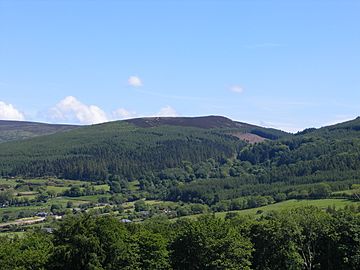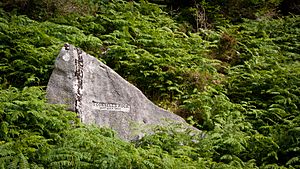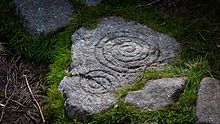Tibradden Mountain facts for kids
Quick facts for kids Tibradden Mountain(Sliabh Thigh Bródáin) |
|
|---|---|
| Garrycastle; Kilmainhambegg | |

Tibradden from Montpelier Hill
|
|
| Highest point | |
| Elevation | 467 m (1,532 ft) |
| Prominence | 30 m (98 ft) |
| Geography | |
| Location | County Dublin, Ireland |
| Parent range | Dublin Mountains |
| OSI/OSNI grid | O1487822281 |
| Topo map | OSI Discovery No. 50 |
Tibradden Mountain (which means "mountain of the house of Bródáin" in Irish) is a mountain located in County Dublin, Ireland. It was once known by other names like "Garrycastle" and "Kilmainham Begg." This mountain stands about 467 meters (1,532 feet) tall.
Tibradden is part of a group of hills in the Dublin Mountains. This group includes Two Rock, Three Rock, and Kilmashogue mountains. From the top of Tibradden, you can see amazing views of Dublin to the north. You can also see Two Rock to the east and the wider Wicklow Mountains stretching to the south and west.
The mountain is mostly made of a type of rock called granite. You can see many large granite boulders scattered on its southern slopes. The summit area is home to plants like heather, furze, gorse, and bilberry. Animals such as Sika deer, foxes, and badgers also live here. The lower parts of the mountain have a forest called the Pine Forest. This forest has many different trees, including Scots pine, Japanese larch, European larch, Sitka spruce, oak, and beech. Tibradden Mountain is also important because it has an ancient burial site near its top.
Contents
History of Tibradden Mountain
What Ancient Monuments Are on Tibradden?
Near the summit of Tibradden Mountain, there is a very old burial site. People used to mistakenly think it was connected to an ancient king named Niall Glúndub. In 1849, experts from the Royal Irish Academy explored the site. They found a stone box, called a cist, which held a pottery pot and the remains of someone who had been cremated. These items are now kept safe at the National Museum of Ireland in Dublin.
Today, the site looks like a round open room about 10 feet (3 meters) across, with a narrow path leading into it. For many years, people thought this was a type of ancient tomb called a passage grave. A famous writer named Robert Graves even mentioned it as such in his book The White Goddess.
However, in 1956, conservation work showed that the open room and passage were not part of the original design. They were likely added during the 1849 excavation. A stone bench was also found inside, probably built for visitors. Now, experts agree that the monument is actually a chambered cairn. This is a pile of stones covering a burial, with the cist burial at its center. Some people believe this might be the burial place of Bródáin, the person the mountain is named after.
The monument is not exactly at the very top of the mountain. It's a little to the north, where the view across Dublin Bay to Howth is clear and not blocked by Two Rock. Inside the chamber, there's a special stone with a spiral pattern carved into it. This ancient site became a national monument in 1940, meaning it is protected by the government.

Exploring Tibradden Mountain
How Can You Visit Tibradden?
You can reach Tibradden Mountain through the Pine Forest. This is a special forest recreation area owned by Coillte, Ireland's state forestry company. The Dublin Mountains Partnership helps manage this area, making it great for visitors.
Tibradden is also part of the Dublin Mountains Way. This is a long hiking trail that stretches between Shankill and Tallaght. Another hiking trail, the Wicklow Way, passes to the southeast of the mountain's summit. The first part of the Dublin Mountains Way to be finished was the section connecting Tibradden, Kilmashogue, and Cruagh forests. A special plaque marks its opening on June 19, 2009. It was opened by Éamon Ó Cuív, who was a government minister at the time.
Near the car park in the Pine Forest, there is another plaque. This one celebrates the start of the Dublin Mountains Partnership on October 24, 2008. It was opened by Eamon Ryan, who was also a government minister then. These partnerships help make sure these beautiful natural areas are open and enjoyable for everyone.




